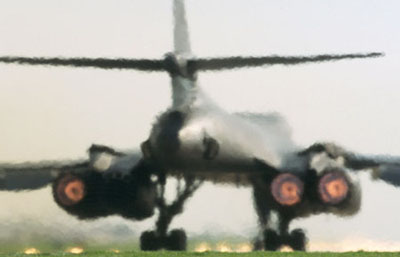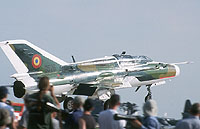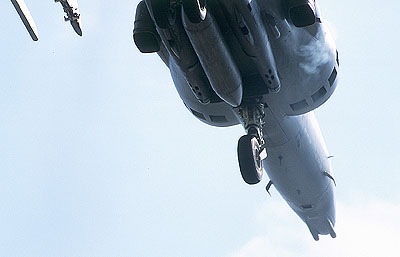Royal
International Air Tattoo Part five: If you can't stand the heat...
 Mike Kerr reflects on a now
infamous incident during the arrivals days. All pictures by the author unless stated
otherwise. Mike Kerr reflects on a now
infamous incident during the arrivals days. All pictures by the author unless stated
otherwise.
 Arrivals days at Cottesmore presented many
excellent photographic opportunities and resulted in vast profits for the film companies.
Variety is the spice of life, and with an airshow the size of RIAT held over several days
the opportunity must be taken to move around the various vantage points on offer. Part of
the challenge is always to make best use of the light, moving as the sun casts different
shadows over the day. Arrivals days at Cottesmore presented many
excellent photographic opportunities and resulted in vast profits for the film companies.
Variety is the spice of life, and with an airshow the size of RIAT held over several days
the opportunity must be taken to move around the various vantage points on offer. Part of
the challenge is always to make best use of the light, moving as the sun casts different
shadows over the day.
 Cottesmore presents a prime spot at the threshold
of runway 23 - over the arrivals days, by parking in the welcoming farmer's adjacent field
and parting with some cash you could make your way to the fence at the north-eastern end
of the airfield. Aircraft were landing from this Cottesmore presents a prime spot at the threshold
of runway 23 - over the arrivals days, by parking in the welcoming farmer's adjacent field
and parting with some cash you could make your way to the fence at the north-eastern end
of the airfield. Aircraft were landing from this  direction all
weekend, so various angles could be explored from side-on, head-on, to underneath. direction all
weekend, so various angles could be explored from side-on, head-on, to underneath.
With planes arriving thick and fast some members of the public had taken the decision to
stand next to the fence right on the centre-line of the runway - rather a foolhardy thing
to do as some of the approaching aircraft were no more than ten feet over the fence,
resulting in many rapidly ducking heads and cries of exclamation. It was only a few months
ago that one such overseas 'enthusiast' lost his head in similar circumstances...Many did
not appreciate the fact that the pilots are probably unaware just how close the spotters
were as the nose-up attitude of an aeroplane on approach severely restricts the view
immediately below.
 One of the later
movements on the Friday was B1B Lancer 86-0104, in preparation for a practice 'display'
(although one would be hard pressed to describe it as such). Taxiing to the 'hold'
position on runway 23, many thought it was the perfect opportunity to get that impressive
'burner' shot. As it turned onto the threshold, photographers and enthusiasts gathered
along the fence behind the idling engines of the mighty beast. Even at a distance of some
four hundred feet, many knew that it would be a 'little draughty' and so lay on the grass
to prevent being blown over; others, however, were not quite so clued-up. At this point on
the airfield, the perimeter fence is only a few feet high, being basically two-strand post
and wire. One of the later
movements on the Friday was B1B Lancer 86-0104, in preparation for a practice 'display'
(although one would be hard pressed to describe it as such). Taxiing to the 'hold'
position on runway 23, many thought it was the perfect opportunity to get that impressive
'burner' shot. As it turned onto the threshold, photographers and enthusiasts gathered
along the fence behind the idling engines of the mighty beast. Even at a distance of some
four hundred feet, many knew that it would be a 'little draughty' and so lay on the grass
to prevent being blown over; others, however, were not quite so clued-up. At this point on
the airfield, the perimeter fence is only a few feet high, being basically two-strand post
and wire.
 The words "Cleared for
take-off" could be easily heard from the multitude of radio scanners in the area. As
the throttles were pushed forward to full afterburner, a shimmering heat haze billowed out
from behind the Bone as it held itself on its mightily powerful brakes. Perfect photo!
Number two engine was proving reluctant to engage full 'burner, so the pilot held it on
the brakes for a few moments longer. Then, it hit. The words "Cleared for
take-off" could be easily heard from the multitude of radio scanners in the area. As
the throttles were pushed forward to full afterburner, a shimmering heat haze billowed out
from behind the Bone as it held itself on its mightily powerful brakes. Perfect photo!
Number two engine was proving reluctant to engage full 'burner, so the pilot held it on
the brakes for a few moments longer. Then, it hit.
A wall of burnt kerosene engulfed the startled crowd assembled by the fence - it was
decision time - stay put or run! Those lying down curled into a ball, the heat rising and
oxygen levels falling. Those who chose to run found themselves picked bodily off the
ground and thrown into the air, tumbling along the ploughed ground as they came back to
earth. Cameras were  scattered, as were chairs and umbrellas with the
force of the 140-knot blast. As the heat continued to rise, those who stayed put were
beginning to doubt their wisdom - surely it will subside in a second? But, the longer that
number two engine refused to fire, the longer was their concern. At approaching 200
degrees F the temperature finally began to subside, as did the buffeting and noise levels
as the Bone finally released the brakes and leapt down the runway. scattered, as were chairs and umbrellas with the
force of the 140-knot blast. As the heat continued to rise, those who stayed put were
beginning to doubt their wisdom - surely it will subside in a second? But, the longer that
number two engine refused to fire, the longer was their concern. At approaching 200
degrees F the temperature finally began to subside, as did the buffeting and noise levels
as the Bone finally released the brakes and leapt down the runway.
Heads were raised to see the Bone rotate, by now at the far end of the runway and climbing
at a forty degree angle. As the dispersed crowd picked itself up, it was apparent that
many had been carried over a hundred yards by the blast - most just shocked by the
severity of it all, but many sported cuts and bruises. The RIAT emergency teams were
swiftly on the scene, sorting out the walking wounded. Four people were taken away for
minor treatment - mainly cuts, as the temperature wasn't enough to seriously burn beyond
improving the tan.
 On reflection it was one of those incidents that could have been
avoided, but in reality everyone simply overlooked the awesome power of the B-1. Yes, the
farmer had told people not to stand there, but as a public footpath crosses the end of the
runway it was difficult to police. It was beyond the control of RIAT, being outside of the
military airfield. Questions have been asked why the B-1 didn't move down the runway 1,000
ft before spooling up - this may have reduced his safety margins to an unacceptable level.
He too was probably unappreciative of the effect of the jet blast some 130 metres behind
him. It also happened at Waddington the month before, despite there being plenty of
'Beware of jet blast' signs, so in retrospect no-one can blame anyone but themselves. On reflection it was one of those incidents that could have been
avoided, but in reality everyone simply overlooked the awesome power of the B-1. Yes, the
farmer had told people not to stand there, but as a public footpath crosses the end of the
runway it was difficult to police. It was beyond the control of RIAT, being outside of the
military airfield. Questions have been asked why the B-1 didn't move down the runway 1,000
ft before spooling up - this may have reduced his safety margins to an unacceptable level.
He too was probably unappreciative of the effect of the jet blast some 130 metres behind
him. It also happened at Waddington the month before, despite there being plenty of
'Beware of jet blast' signs, so in retrospect no-one can blame anyone but themselves.
 It
seems that in the interests of safety during the two flying days the area was closed to
the public with footpath closure signs hastily erected. It
seems that in the interests of safety during the two flying days the area was closed to
the public with footpath closure signs hastily erected.  B-1B departures are unusual
for Cottesmore - with the return to Fairford next year, it may be some time before Lancers
leave Rutland in such spectacular fashion. What mustn't happen is a knee-jerk reaction -
no-one was seriously hurt, after all. Life is about experiences, and this was certainly
one of them to many - as RIAT is unlikely B-1B departures are unusual
for Cottesmore - with the return to Fairford next year, it may be some time before Lancers
leave Rutland in such spectacular fashion. What mustn't happen is a knee-jerk reaction -
no-one was seriously hurt, after all. Life is about experiences, and this was certainly
one of them to many - as RIAT is unlikely  to return to Cottesmore in the
foreseeable future, it is best to let the matter lie, just as many should have thought to
do that day! to return to Cottesmore in the
foreseeable future, it is best to let the matter lie, just as many should have thought to
do that day!
|

